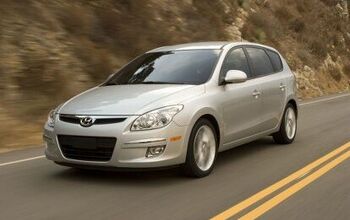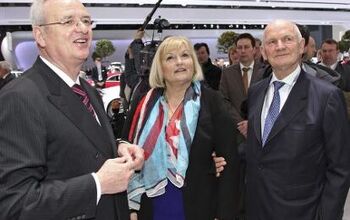By the Numbers: August Sales Not So August
August's U.S. sales results are in. Upon their release, GM crowed about their market-bucking triumph– neglecting to mention the fact that 25 percent of those sales sailed with the fleets. Meanwhile, Chrysler blamed its sales decline on diminished fleet flogging. Ford was "encouraged by sales of their crossover vehicles" (i.e. stuck in the dog house). And Toyota pinned their sales drop on the subprime lending crisis and a supply-line-interrupting Japanese earthquake. Whatever. Bottom line: August wasn't kind to many of the models we're tracking on your behalf.
Passenger Cars
Despite GM's hefty commercial sales, their Chevrolet Impala fleet queen fell 4.5 percent below last August's sales total. Year-to-date (YTD), Impala sales rose 14.8 percent over 2006. Chrysler must have stopped dumping 300 s into the fleets; sales plunged almost 23 percent from last August, down 15 percent YTD. The Ford Fusion dropped 19 percent from last August, although holding steady with a 0.38 percent YTD increase. Camry sales leveled off, up one percent over last August. The longer-term trend is upwards, with a 7.3 percent increase YTD.
Pickup Trucks
After ramping up Silverado incentives, the pickup's sales picked up by 16K units from last August. While that's a whopping 31 percent surge, YTD they're down 2.2 percent. Huge rebates didn't help the Dodge Ram; sales fell 5.5 percent, down 1.3 percent YTD. Ford offered small-to-moderate rebates on their F-Series pickups, failing to forestall a 9.9 percent tumble, dragging the model down 12 percent YTD.
Toyota backed off incentives on Tundra. Sales dropped by 5K units from July to August. But the new Tundra is still kicking the old Tundra's ass. Sales rose 69 percent from last August, up 58 percent YTD.
Truck-Based SUVs
Sales of "traditional" SUVs continue to slide as fuel-conscious consumers make the move to CUVs and family sedans. Sales of Chevrolet's Tahoe went down by eight percent from last August, 14.8 percent YTD. The Dodge Durango plunged 41 percent from last August, down 27 percent year to date. The Ford Explorer's drop wasn't quite as precipitous but it was still down 26 percent from last August and 23 percent YTD. Toyota 4Runner sales were actually up slightly, rising one percent from last August. But they're still down 18.4 percent YTD.
CUVs
As predicted, SUV refugees are igniting sales of CUVs; as the former drops, the latter rises. The Chevrolet Equinox helped power GM's August increase with a 13.5 percent gain. That said, Equinox sales fell by 23 percent YTD. Chrysler's Pacifica continues to tempt the executioner's blade, with sales down 48 percent from last August and 27.6 percent YTD.
Ford continues to pin its hopes on the Escape. It didn't fail them. Sales of FoMoCo's cute-ute rose by 4.4 percent over last August, up 3.2 percent year to date. The redesigned-for-‘07 Toyota RAV-4 continues to sell well; August sales were up by 11 percent, 13 percent YTD.
New Models
All three of our new-for-07 models had been dropping since May. All three showed some recovery in August. The GMC Acadia picked up almost 200 additional sales from July– but still clocked in some 3.2K below May's peak. Even so, the Acadia remains the most popular of GM's Lambda-platform CUVs, selling 5.8K in August (vs. Enclave's 3.8K and Outlook's 3.2K). The Ford Edge and Jeep Compass both showed strong gains over July, each selling around 1100 additional units.
Total Sales
As most anyone who follows the auto industry knows, GM's total sales were up six percent from the same month last year. However, even with that strong sales spurt, they're down 7.4 percent YTD, with production cuts set to slice both sales and share even deeper.
Chrysler's down six percent from last August, down 14 percent YTD. While decreased fleet sales certainly played a part in the decline, we're thinking a combination of uncertainty over the future of the company and a truck/SUV-heavy product line were more significant factors.
Ford' s in a similar situation and their numbers show it. The Blue Oval Boyz' August sales sank by 14.4 percent; a 12.5 percent drop YTD. Proving that even a perennial sales champ isn't entirely immune to market forces and economic meta-fluctuations, Toyota' s August sales dropped 2.8 percent. But they're still up 4.9 percent YTD.
The Future
GM's set to introduce their latest Hail Mary model: the Chevrolet Malibu. Honda's refreshed Accord should keep the ‘Bu from conquesting quality-conscious buyers, and gives Toyota's Camry buyers something to think about.
Chrysler's in flux; their new CEO's still figuring out what to keep and what to cut. Ford's still relying on their truck/SUV/CUV lineup to carry them. And Toyota's juggernaut chugs on.
All of them (and the rest) are sailing straight into economic headwinds. It's been a tough year for the U.S. auto industry– that's about to get a whole lot tougher.
More by Frank Williams
Latest Car Reviews
Read moreLatest Product Reviews
Read moreRecent Comments
- Daniel J Cx-5 lol. It's why we have one. I love hybrids but the engine in the RAV4 is just loud and obnoxious when it fires up.
- Oberkanone CX-5 diesel.
- Oberkanone Autonomous cars are afraid of us.
- Theflyersfan I always thought this gen XC90 could be compared to Mercedes' first-gen M-class. Everyone in every suburban family in every moderate-upper-class neighborhood got one and they were both a dumpster fire of quality. It's looking like Volvo finally worked out the quality issues, but that was a bad launch. And now I shall sound like every car site commenter over the last 25 years and say that Volvo all but killed their excellent line of wagons and replaced them with unreliable, overweight wagons on stilts just so some "I'll be famous on TikTok someday" mom won't be seen in a wagon or minivan dropping the rug rats off at school.
- Theflyersfan For the stop-and-go slog when sitting on something like The 405 or The Capital Beltway, sure. It's slow and there's time to react if something goes wrong. 85 mph in Texas with lane restriping and construction coming up? Not a chance. Radar cruise control is already glitchy enough with uneven distances, lane keeping assist is so hyperactive that it's turned off, and auto-braking's sole purpose is to launch loose objects in the car forward. Put them together and what could go wrong???


































Comments
Join the conversation
pch101, No one else is posting on this thread its old by now. Incentives are a "tactical lever" that manufacturers use to achieve a variety of objectives. Lowering inventory is only one of those objectives. Incentives in a saturated North American automotive marketplace, play many roles. Obvious that a high inventory of an older product which needs to get produced since shutting down the plant would be just as expensive, and the manufacturer got a little crazy building the stuff in the first place. A 4,000 incentive on an old Dodge Ram competing against a 3,000 incentive on a new Toyota Tundra. Its easy to say that the Toyota must be a better product since it requires less incentive.